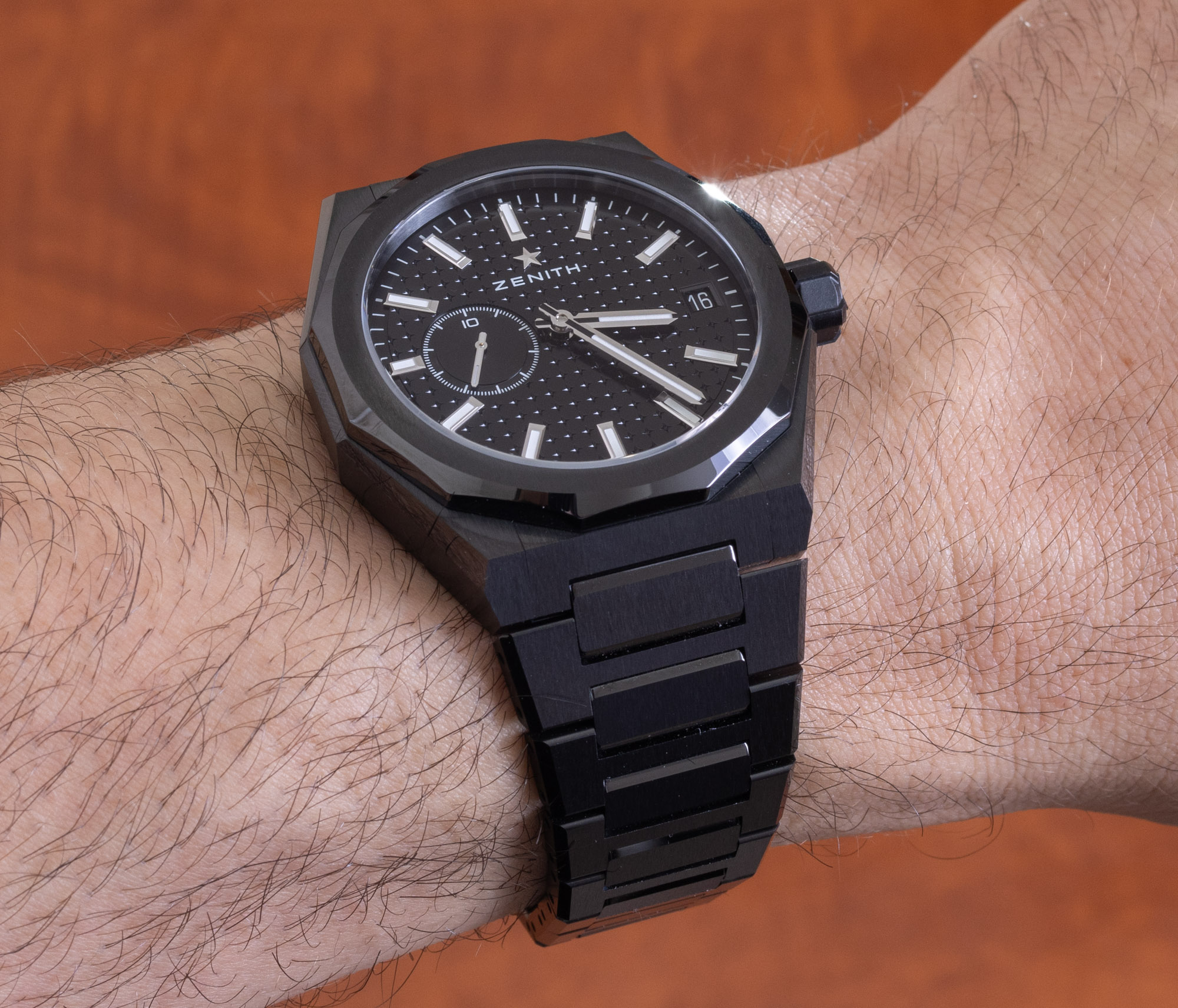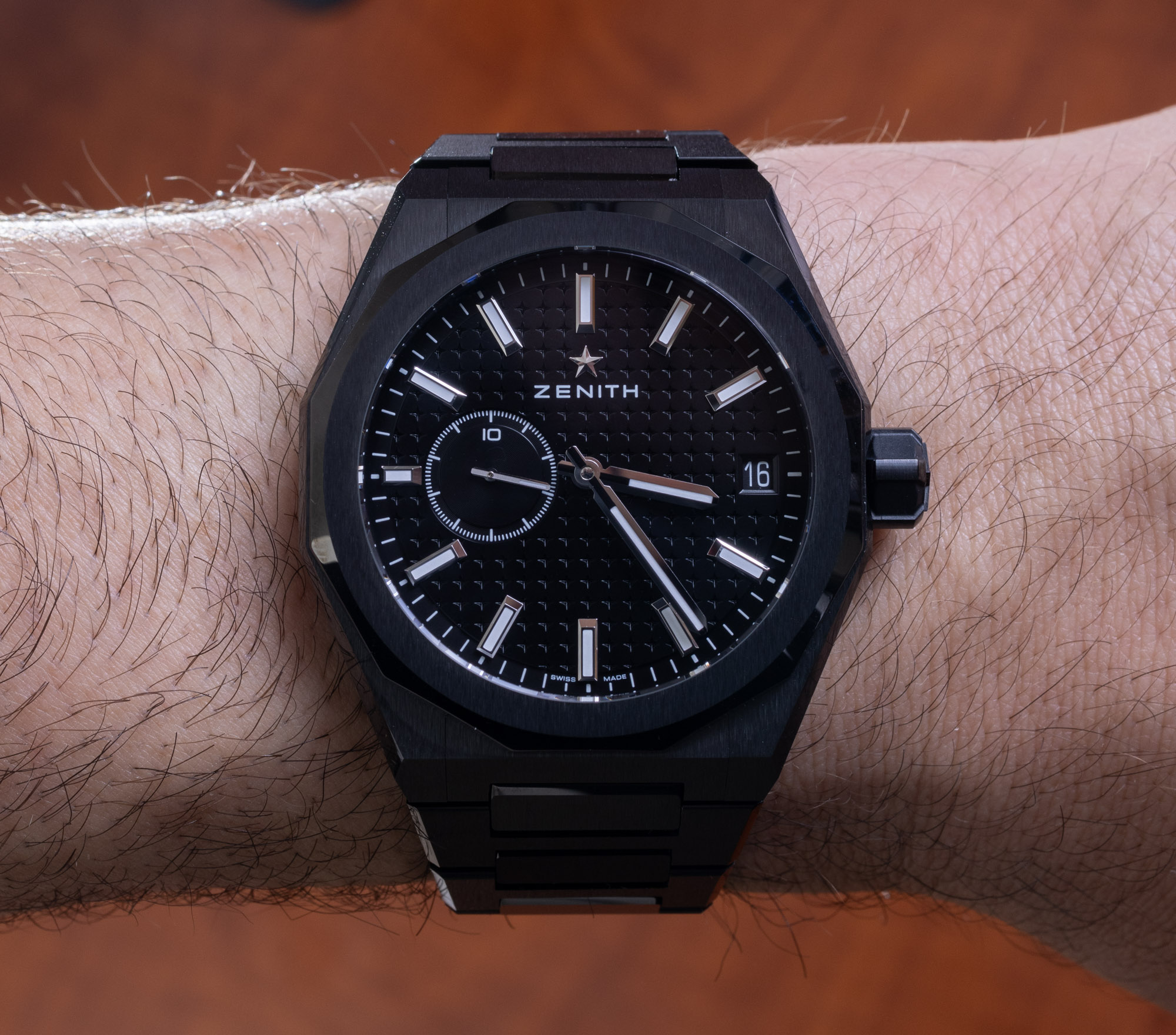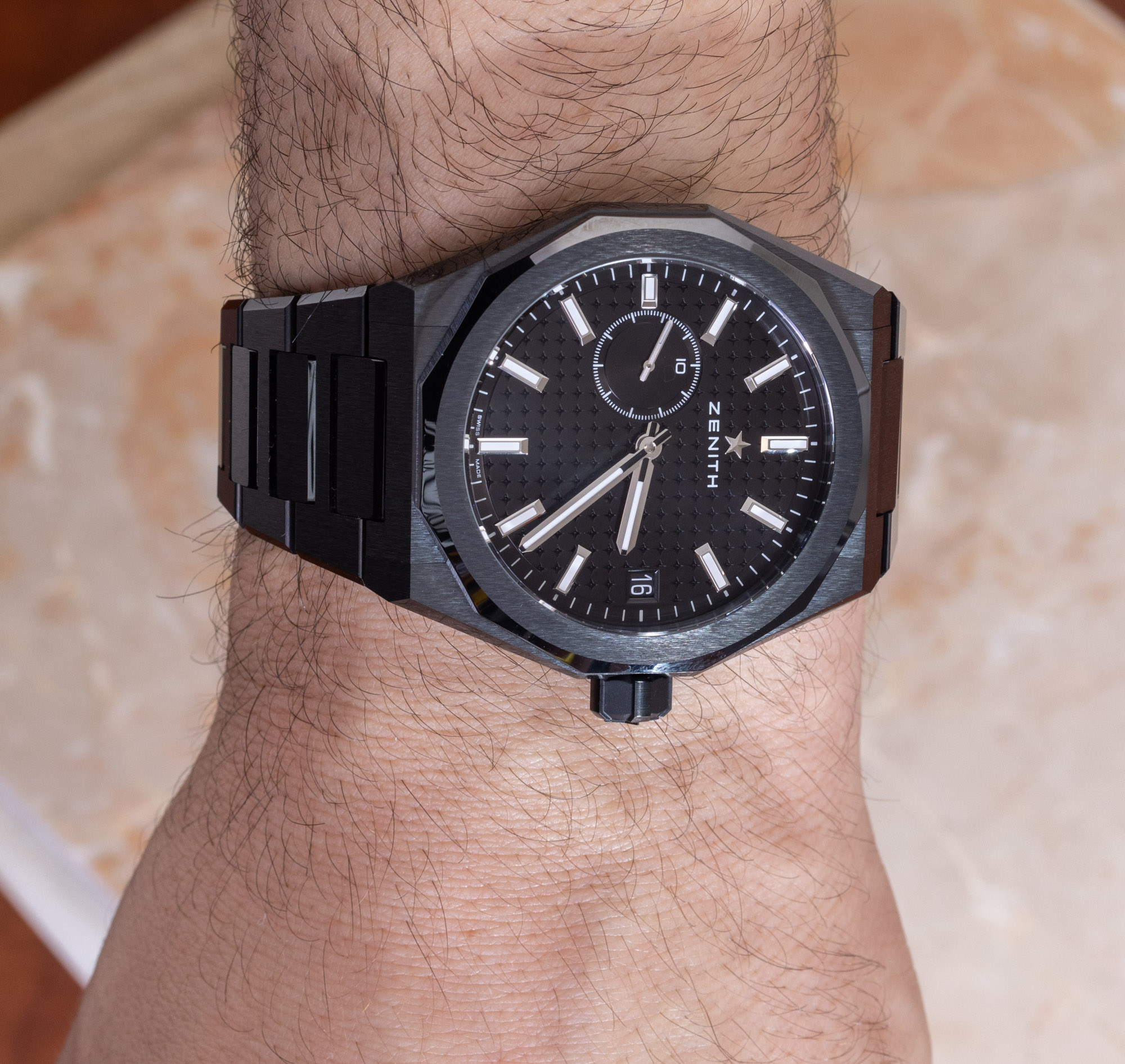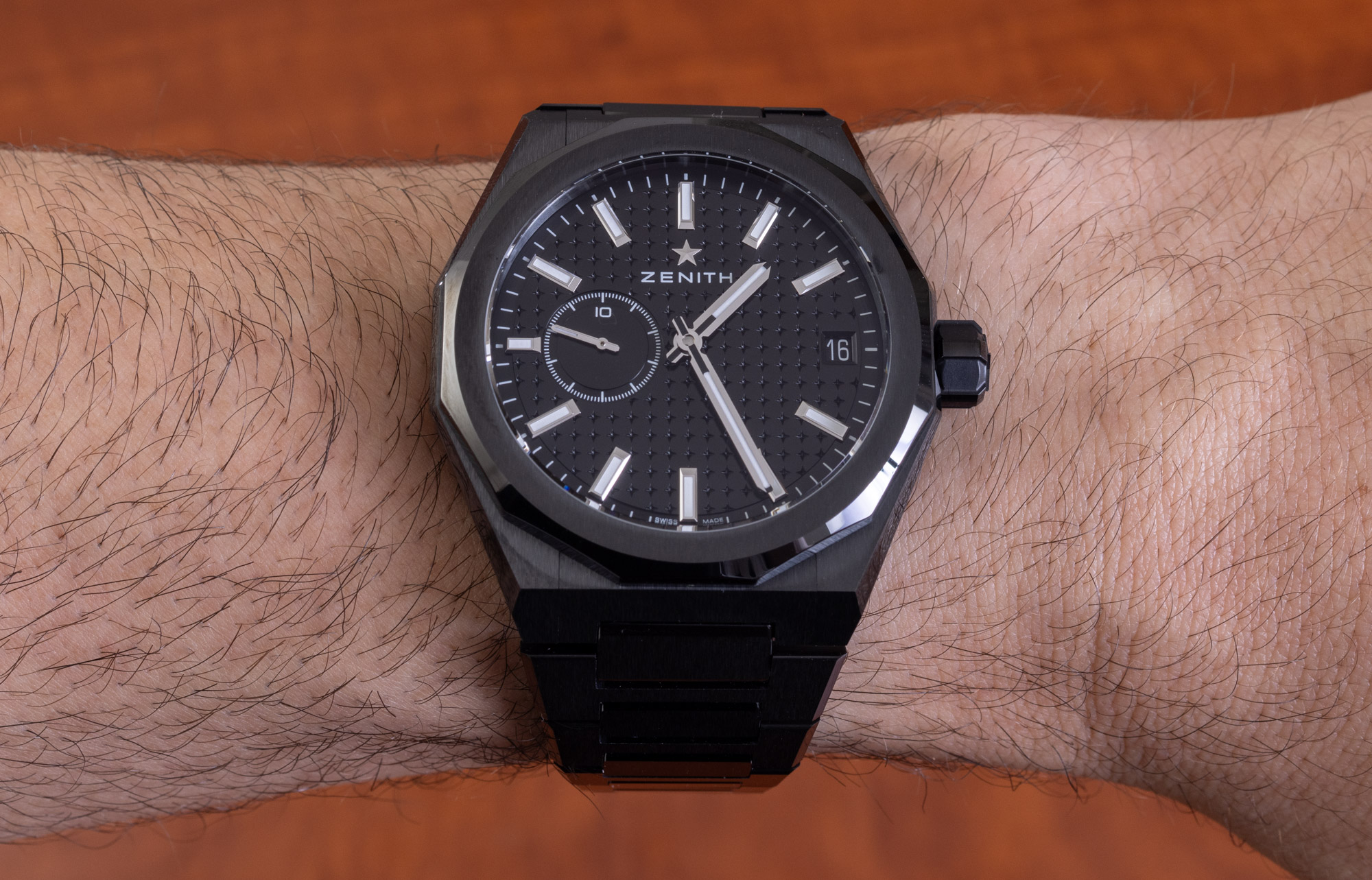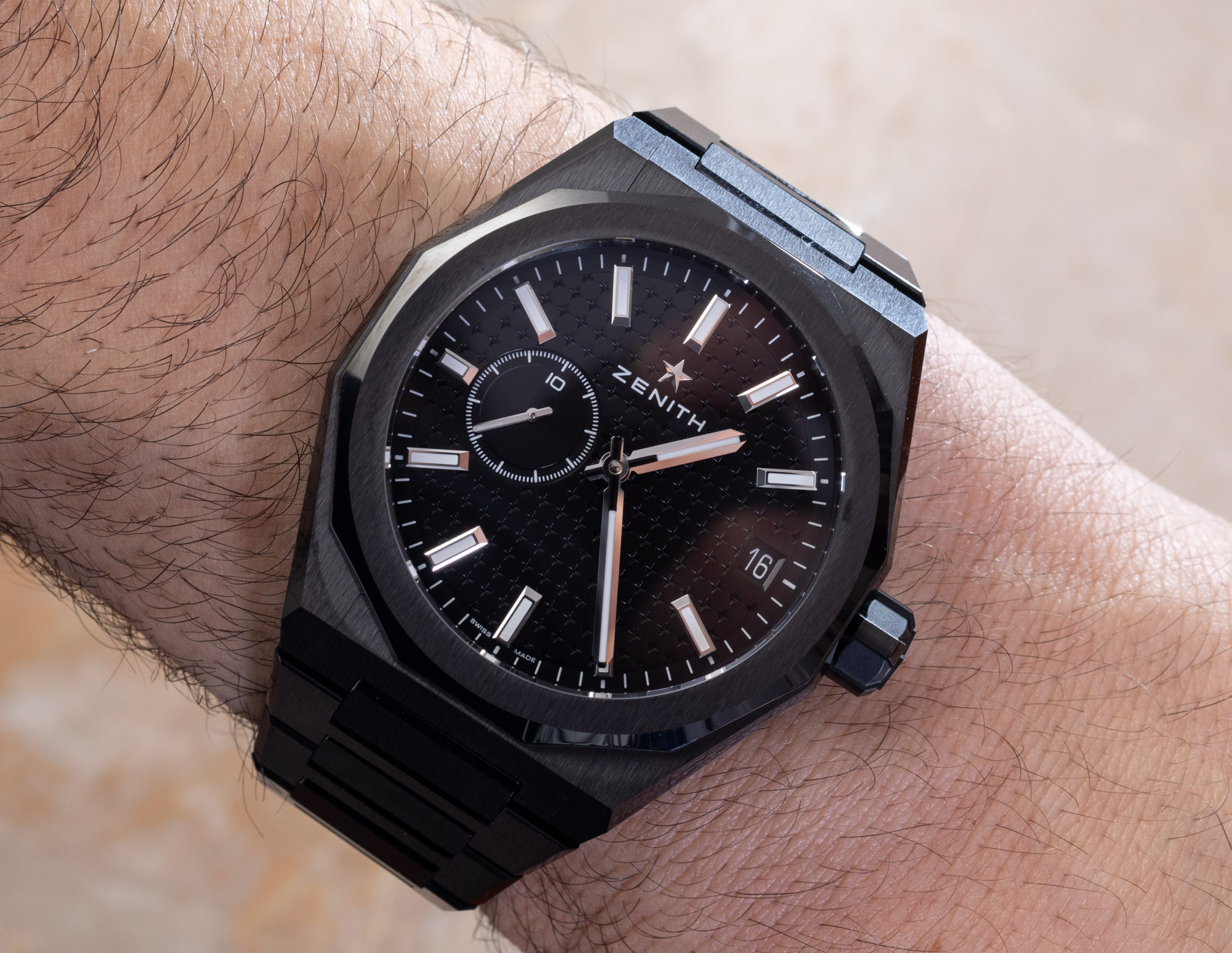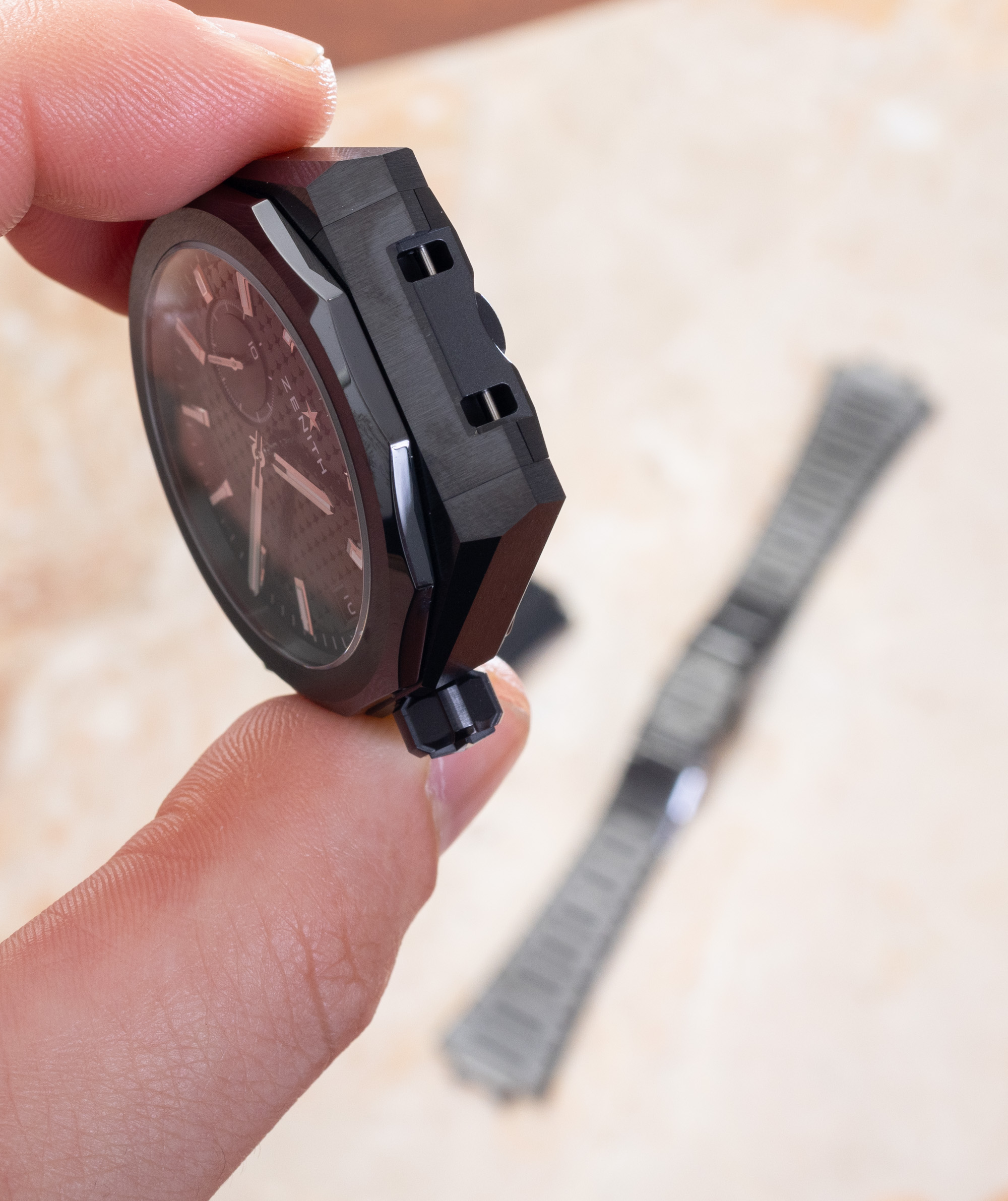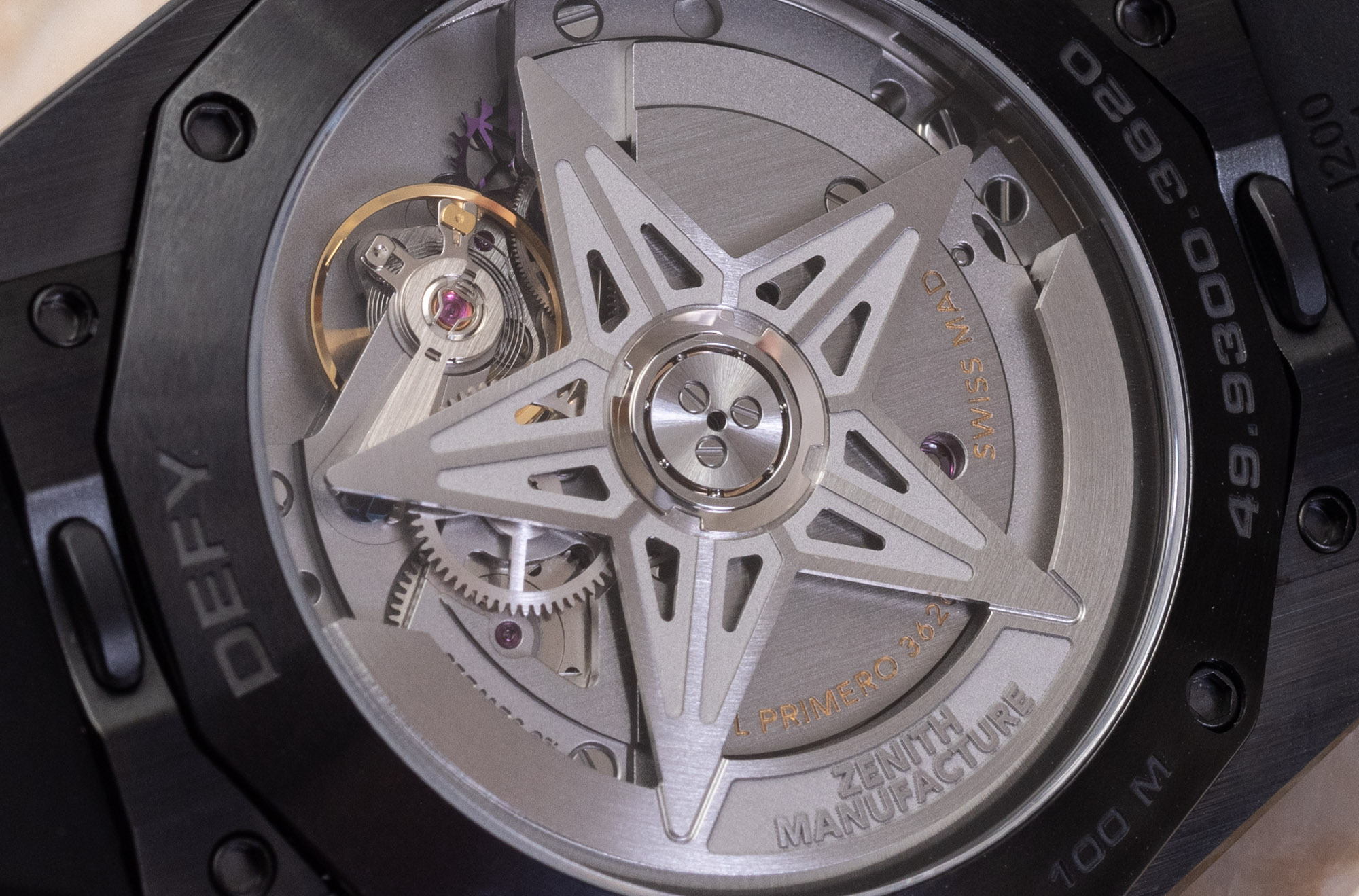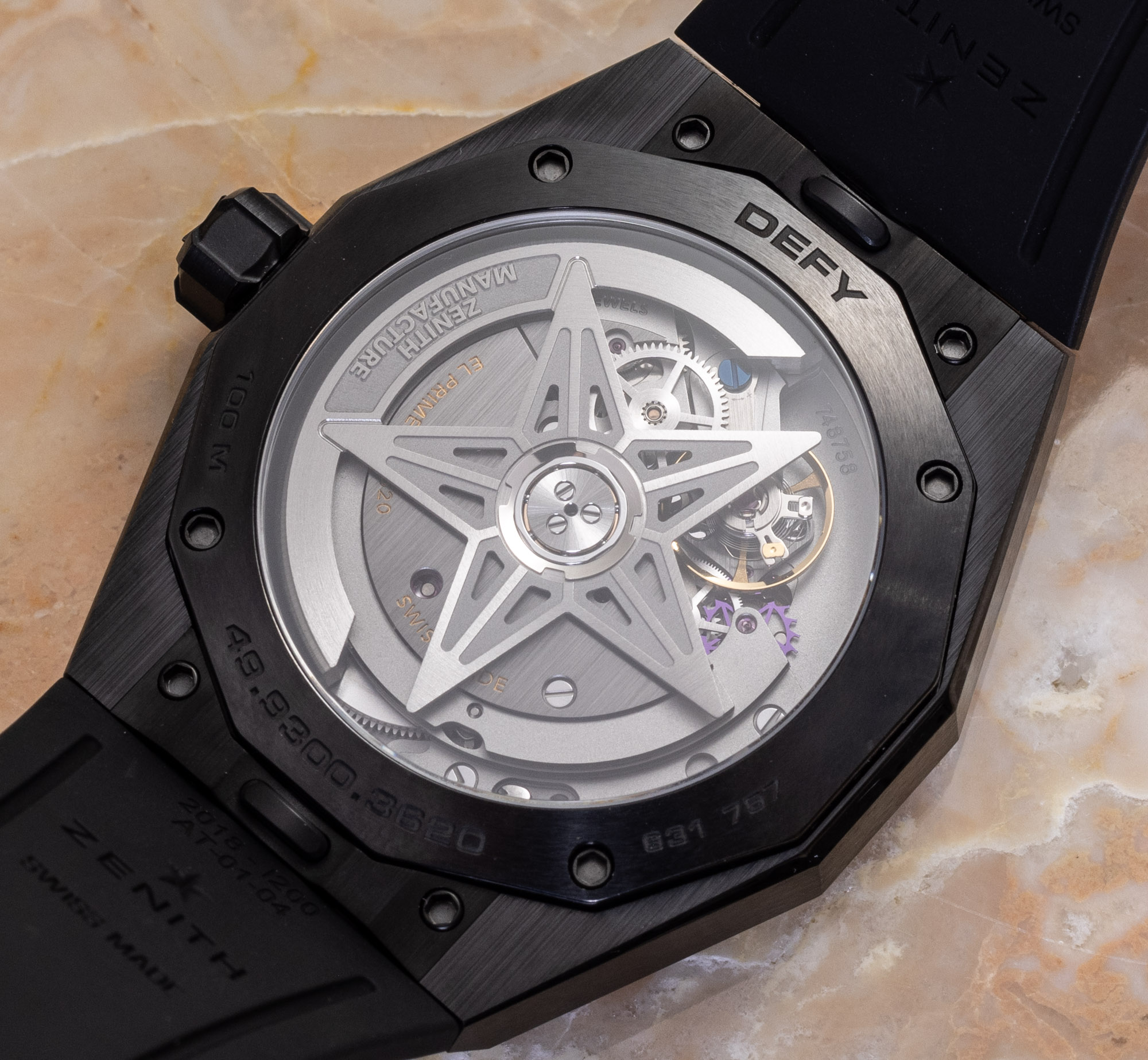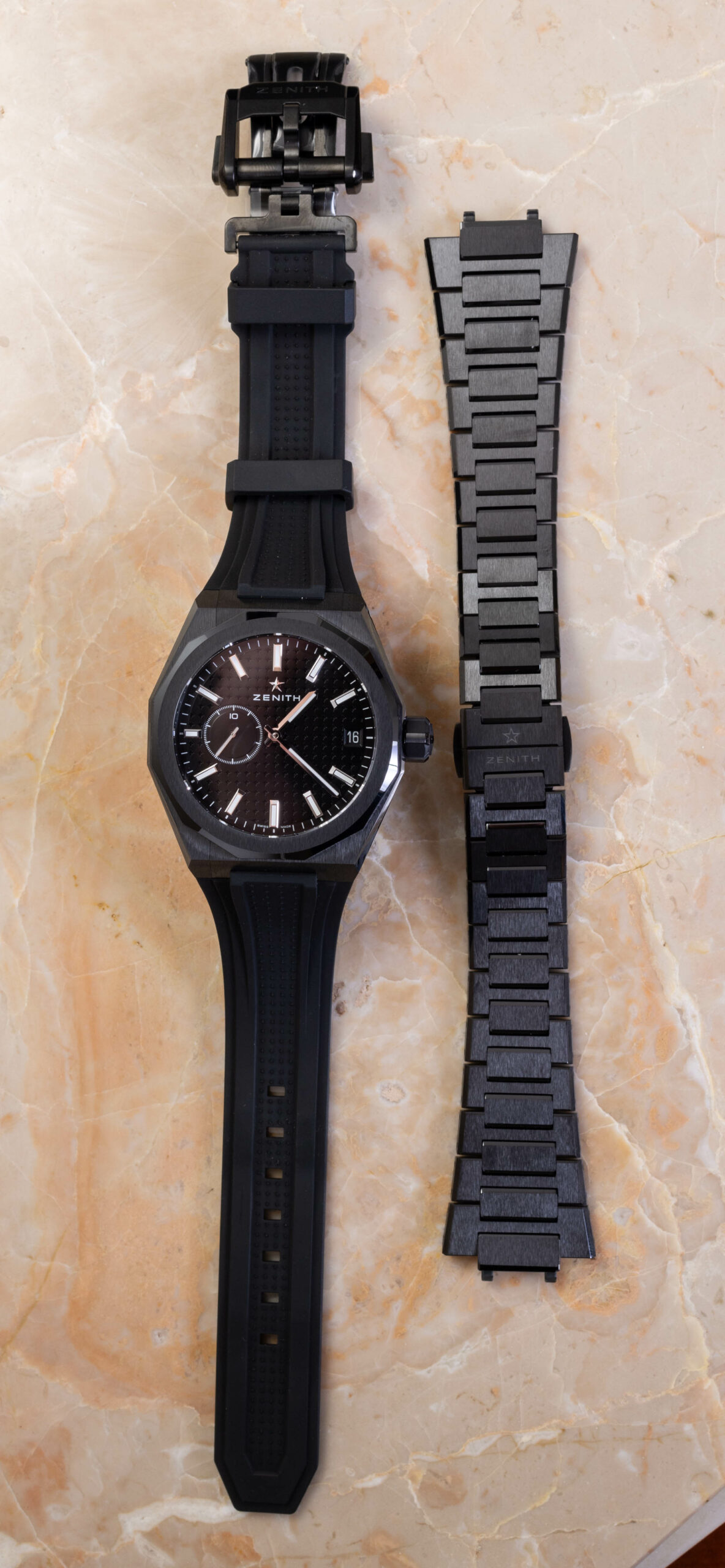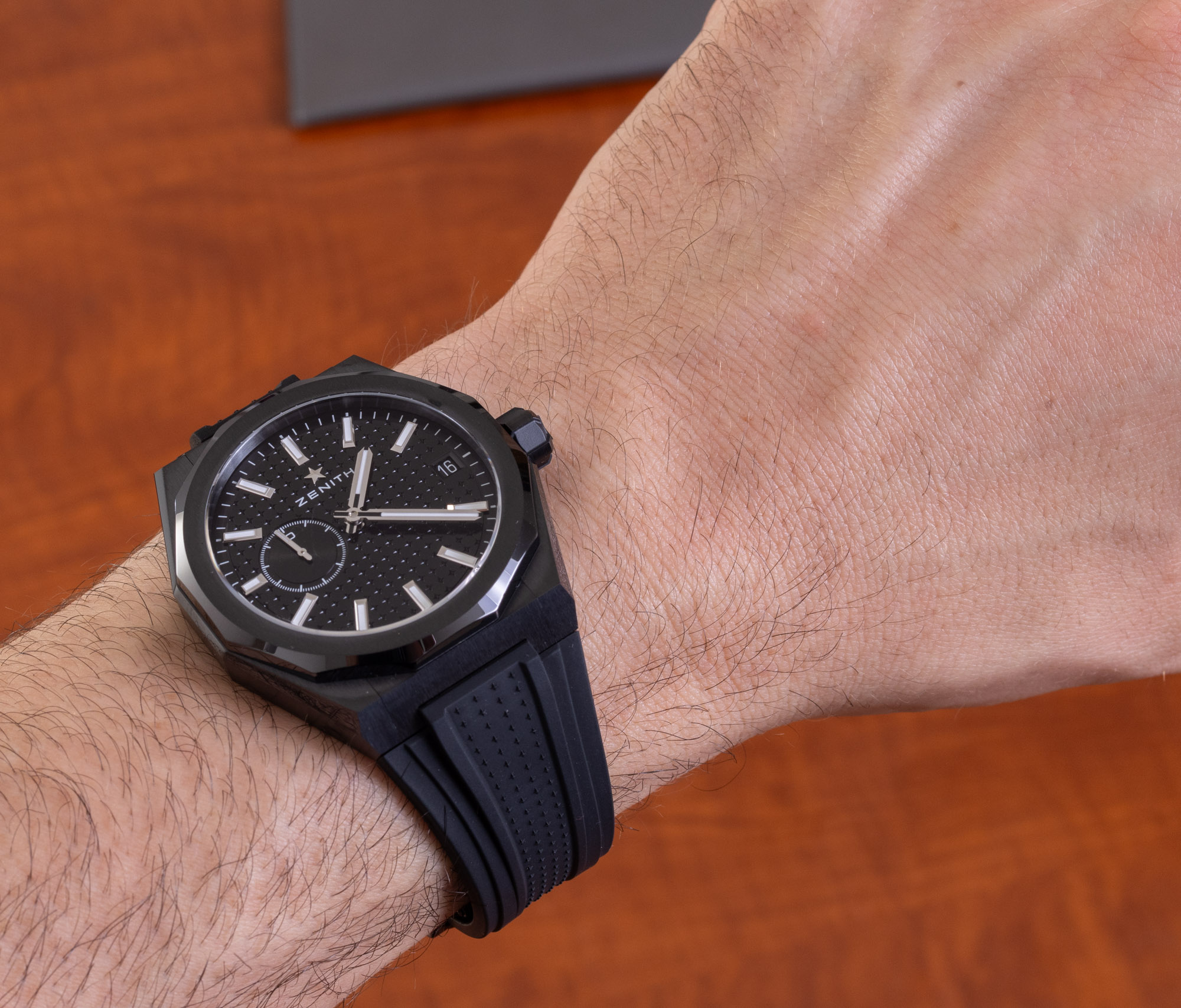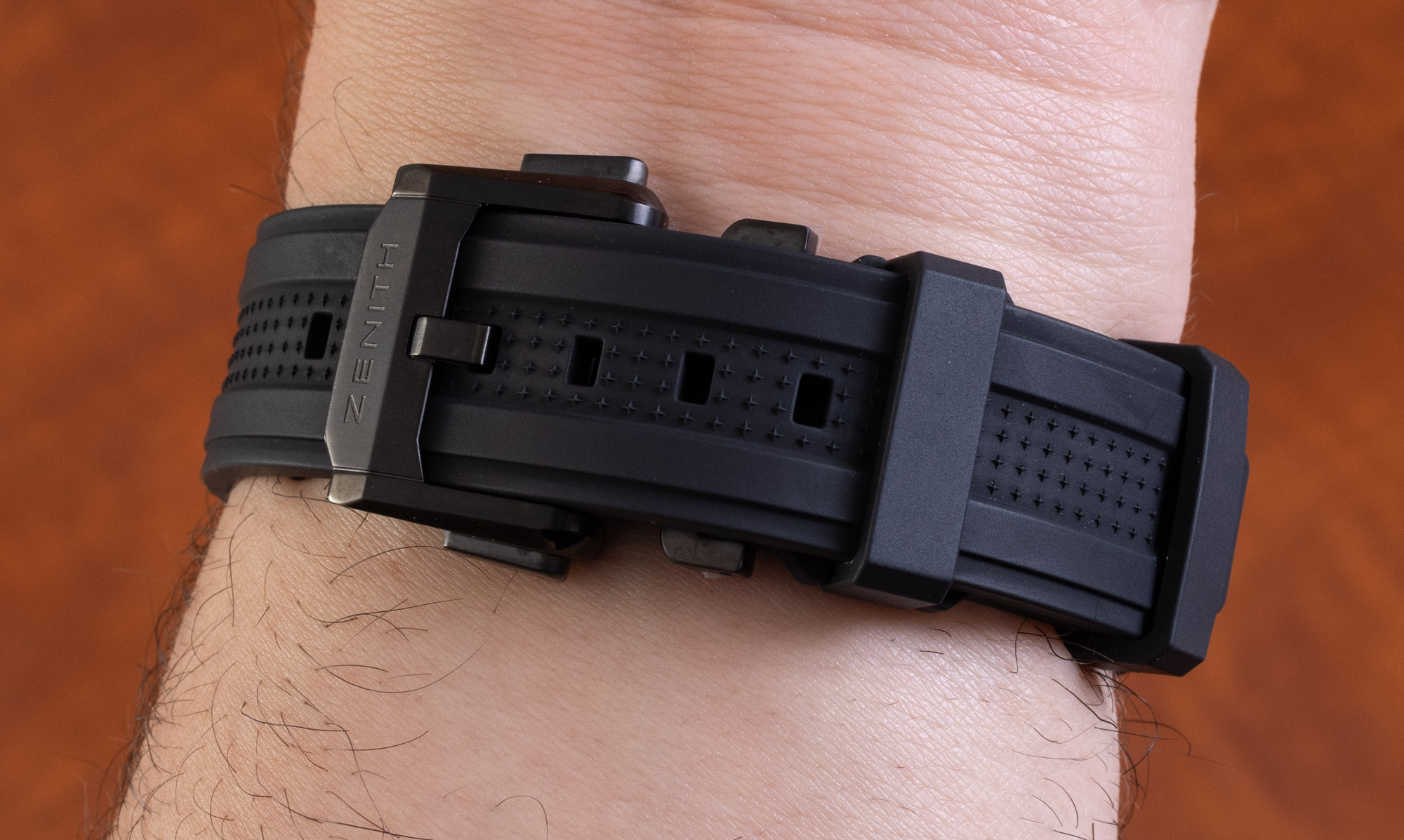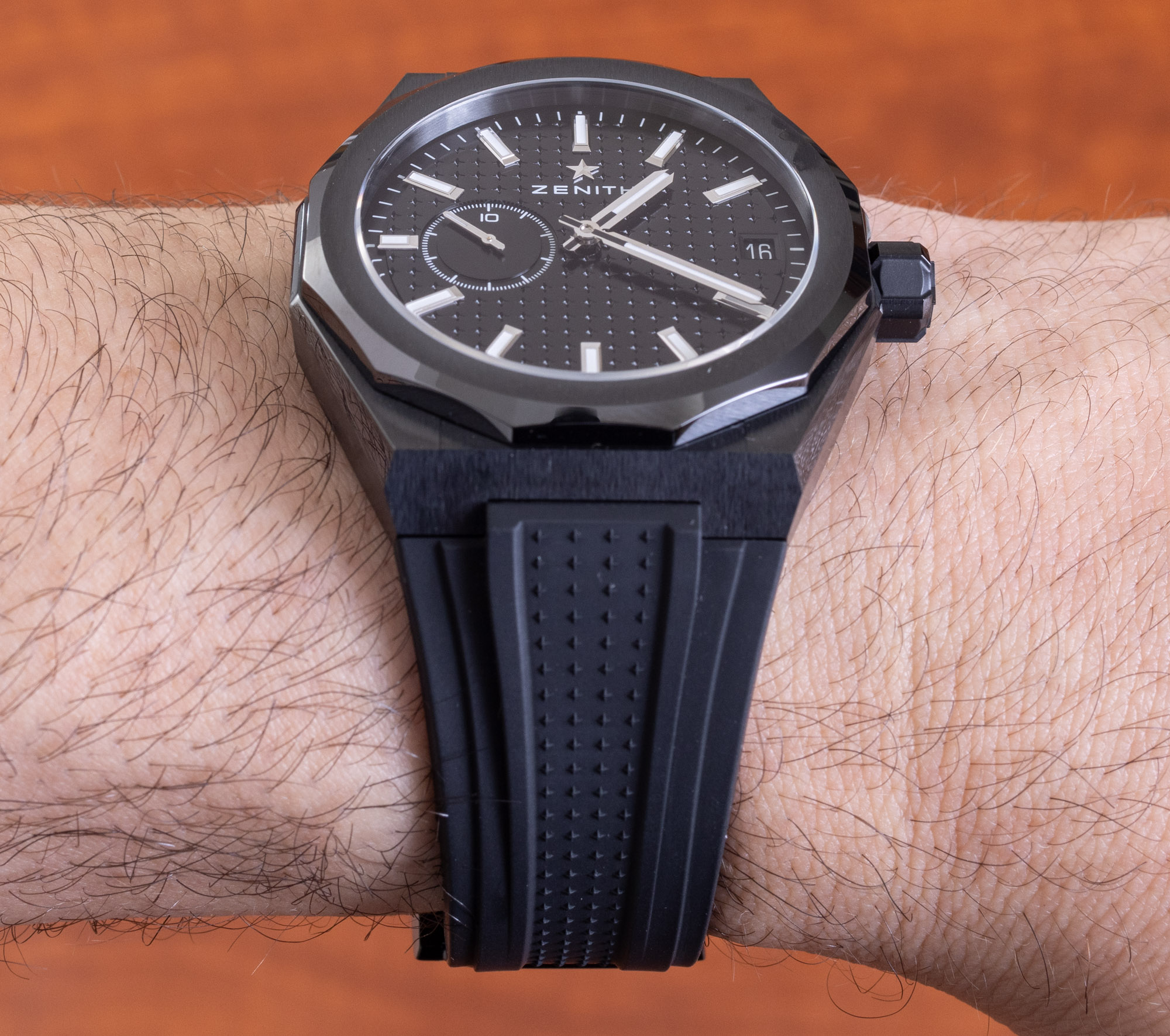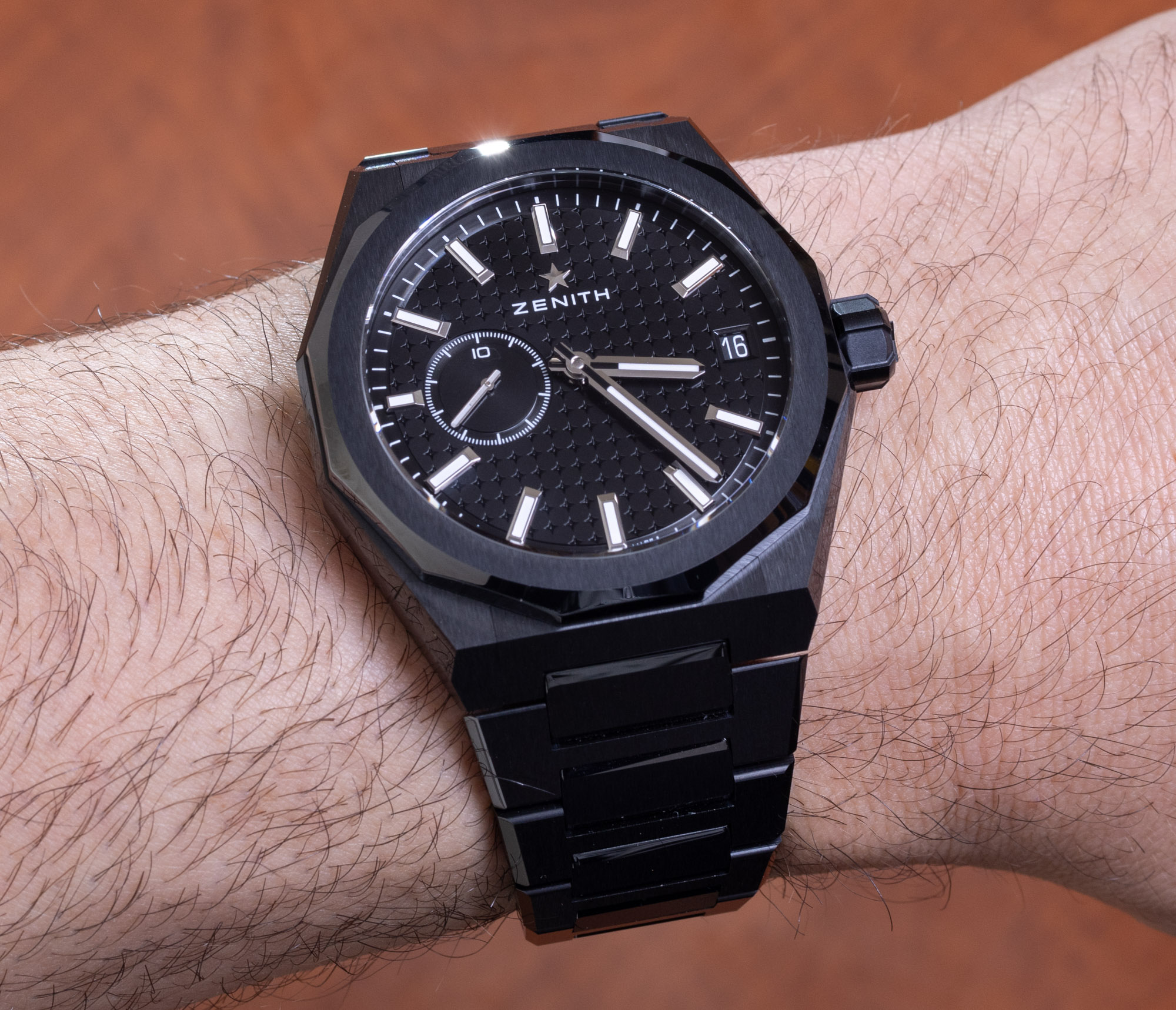
There were two primary reasons I was eager to review this black ceramic version of the still-new Zenith Defy Skyline collection. The first was that, after originally checking out this sub-family of the Zenith Defy series, I was really compelled by this quirky yet comfortable-for-daily wear “sports lifestyle” watch from the Swiss brand and wanted to get to know it better. Few watches really satisfy the comfort and convenience of a daily-wear timepiece, and that is what Zenith was clearly going for in this particular integrated bracelet-style watch. The second was because it has both a ceramic case and bracelet. No, this is not the first ceramic bracelet watch I have worn, but they are still rare. People worry about their fragility and how it might feel to wear a bracelet made up of so many sharp, relatively fragile links. Zenith makes a watch identical to this black ceramic reference 49.9300.3620/21.I001 that comes with a steel case and bracelet. Having worn them both now, how do these bracelets compare? These are some of the questions I had going into reviewing the Zenith Defy Skyline in black ceramic.
Previously, when going hands-on with the steel version of the Zenith Defy Skyline, I spent more time talking about the variety of compelling features Zenith designed into this product. I will discuss some of those in this article, but there is more information there in regard to why Zenith launched the Defy Skyline in 2022 and what was happening in the market. What is still happening in the market is the popularity of integrated bracelet sport watches with models like the Audemars Piguet Royal being among the archetype models. It is no accident that the Zenith Defy Skyline looks like a Gerald Genta-designed Royal Oak at a glance. Zenith, of course, offers something original but is clearly trying to appeal to a particularly strong market demand with the styling of the Defy Skyline. This has been a strategy that has worked well for the company, which is more noteworthy as a historic movement maker than a sheer design leader. It offers high-beat movements and fair prices for products that are often focused on current market trends.
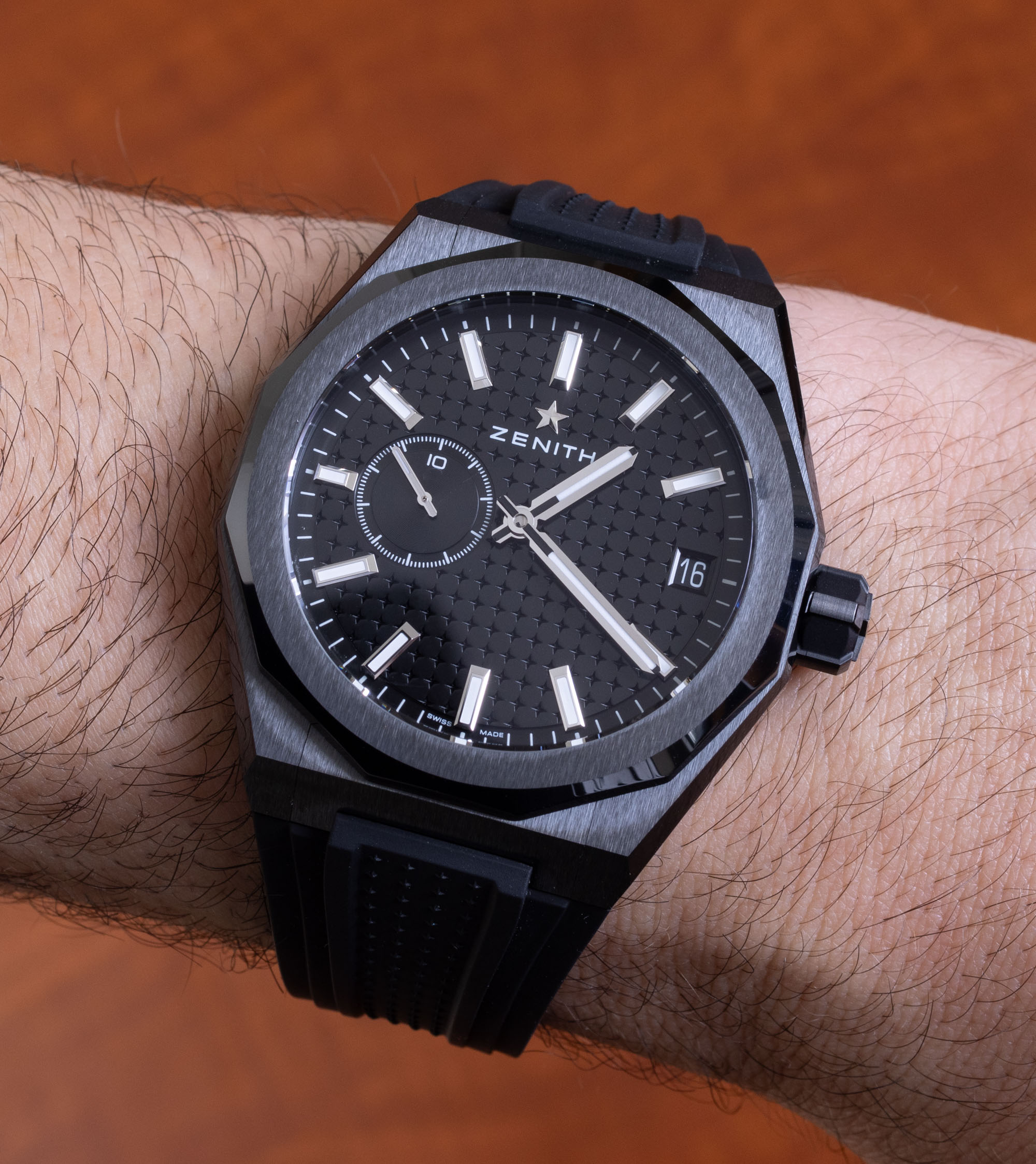
However, you feel about the originality of the Zenith Defy Skyline, it is a handsome and fun watch to wear. The case is going to be thicker than most Royal Oaks but, otherwise, there is a similar on-the-wrist experience (which is a positive one). Unlike the Royal Oak and most of the competition, Zenith includes both a matching bracelet and rubber strap (on a folding deployant clasp) with each of the Defy Skyline watches. Both the strap and the bracelet are further attached with their own toolless quick-release system. That makes it very convenient to change between the strap and bracelet should you wish to. Why wear the strap when the bracelet is so obviously the most handsome choice? The answer is that the bracelet isn’t always the most practical choice. If you are doing any real sporting activities or simply moving around a lot in the heat, the rubber strap is often a more comfortable choice.
People will debate as to whether or not a ceramic case can be truly considered sporty in the same way a metal case is. It is true that while ceramic easily beats metal when it comes to scratch resistance, metal is still the better material for shock and impact. The right smack could crack or break a ceramic case (or bracelet for that matter). While the same impact would only cause a metal case to possibly dent given metal’s ability to deform, ceramic minerals such as sapphire are stiffer materials. Still, this is not a puny ceramic case, and it offers 100 meters of water resistance. I would take off the ceramic bracelet if I wanted to be sporty with this watch, but otherwise, I don’t think people will have any issues taking this ceramic Defy Skyline where a metal one would go.
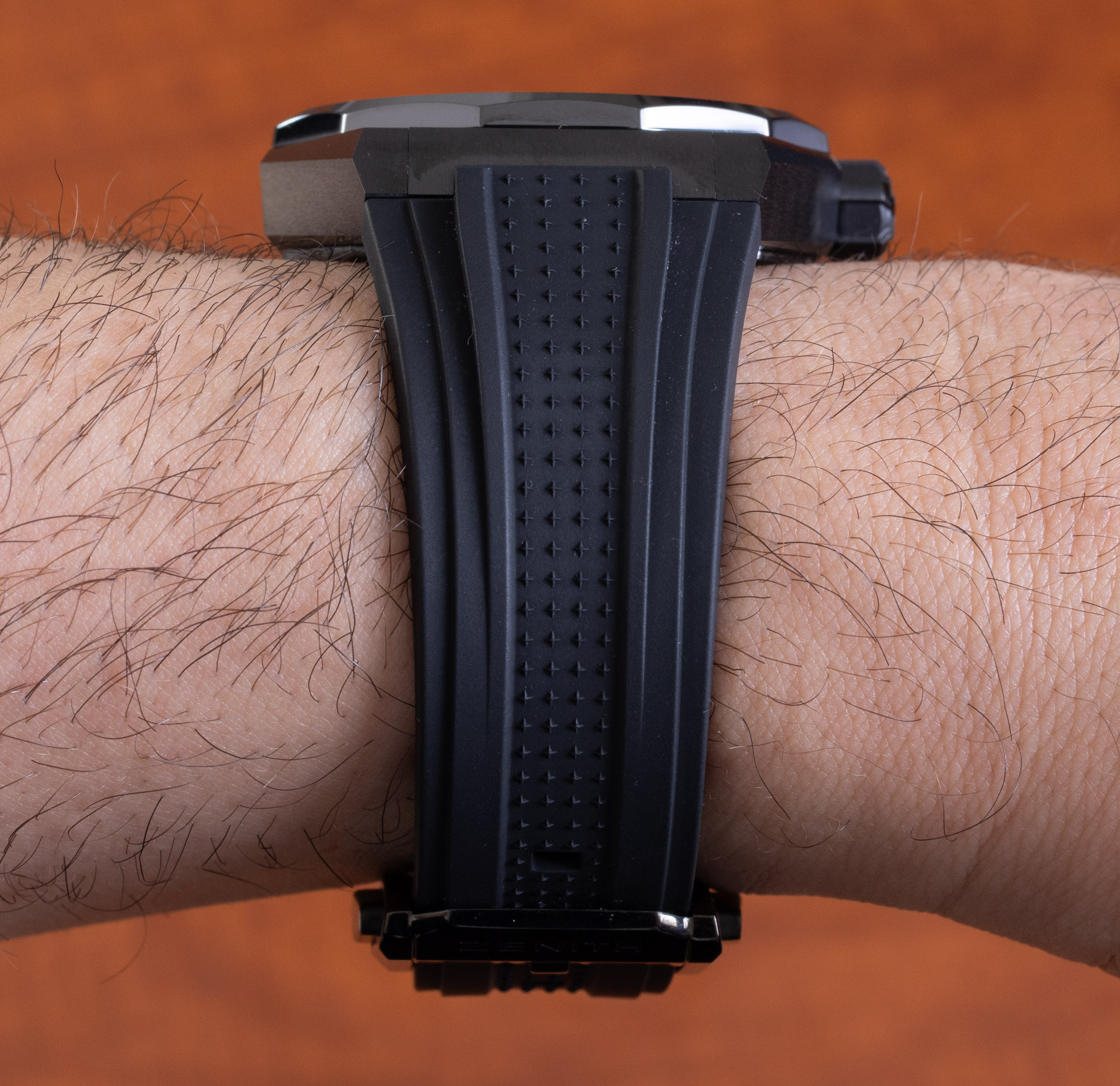
The Zenith Defy Skyline is on the larger size at 41mm wide, with wide lugs and roughly 12mm of case thickness and about 47mm as the lug-to-lug distance. The black color of this ceramic model hides some of its girth in comparison to the steel model, but this isn’t an ultra-thin watch or case. It doesn’t feel overly thick, but the most immediate thing Zenith can do if it ever wants to make the Defy Skyline an even more compelling product is to shave 2-4mm off the case thickness. Over the dial is a flat AR-coated sapphire crystal, with another crystal on the caseback offering a view of the attractive in-house El Primero automatic movement.
What Zenith did to the El Primero 3620 movement is a bit odd, but it does add to the wristwatch’s overall personality. Most Zenith El Primero movements are chronographs; Zenith developed the world’s first such high frequency (36,000 beats per minute versus the more common 28,800 bpm operating frequency many other sports chronographs perform at) in the late 1960s as a way of having more accurate stopwatches on the wrist. Part of the appeal of high-frequency mechanical movements today is how fast the chronograph hands move. Zenith and sister company TAG Heuer have, for the last 20 years, offered most of the horological world’s very high-frequency mechanical movements. The takeaway is that people really like fast-moving hands. So, in addition to the intellectual fascination of having a more precise mechanical chronograph, a lot of watch lovers seemed fixated on rapidly moving small hands on a watch dial.
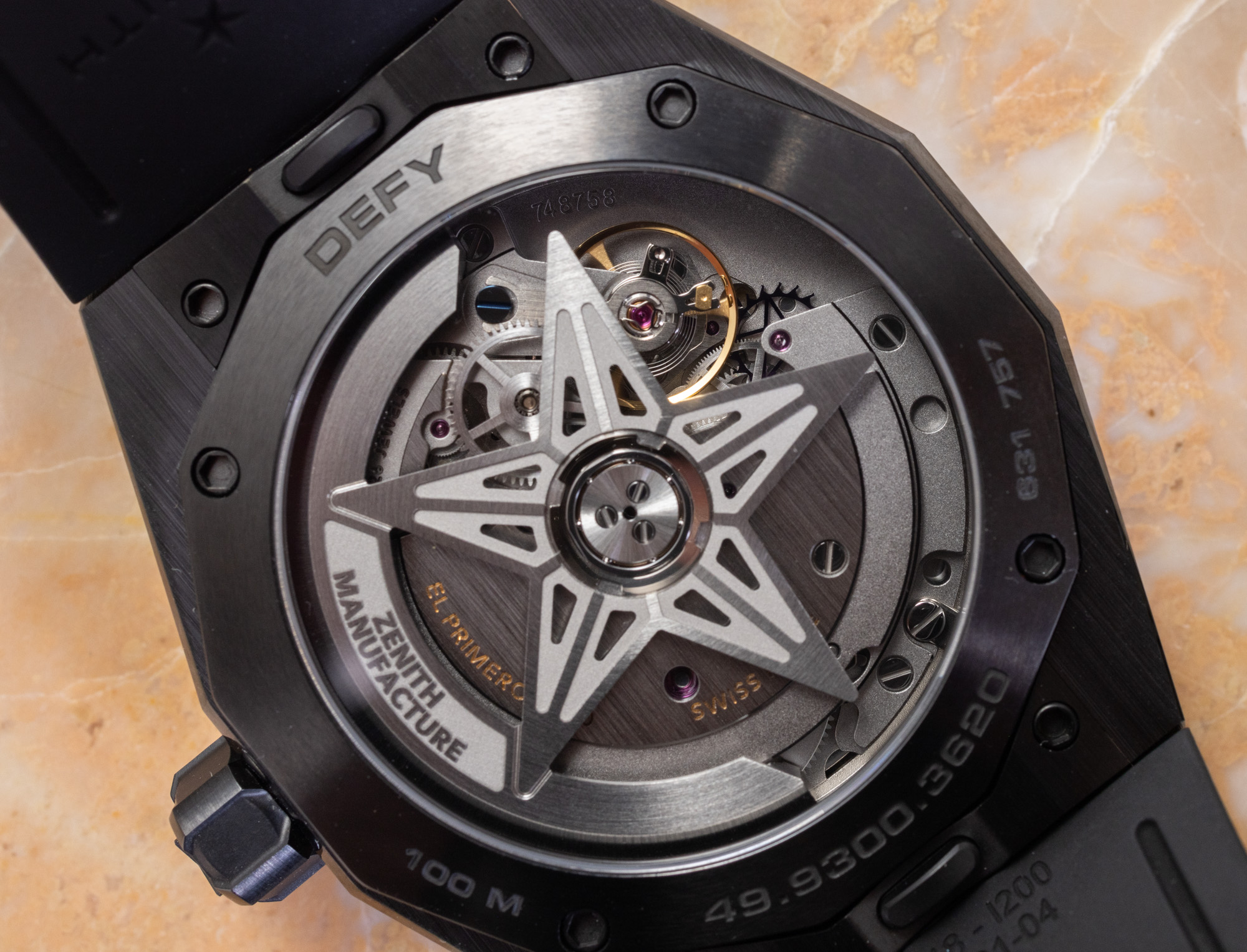
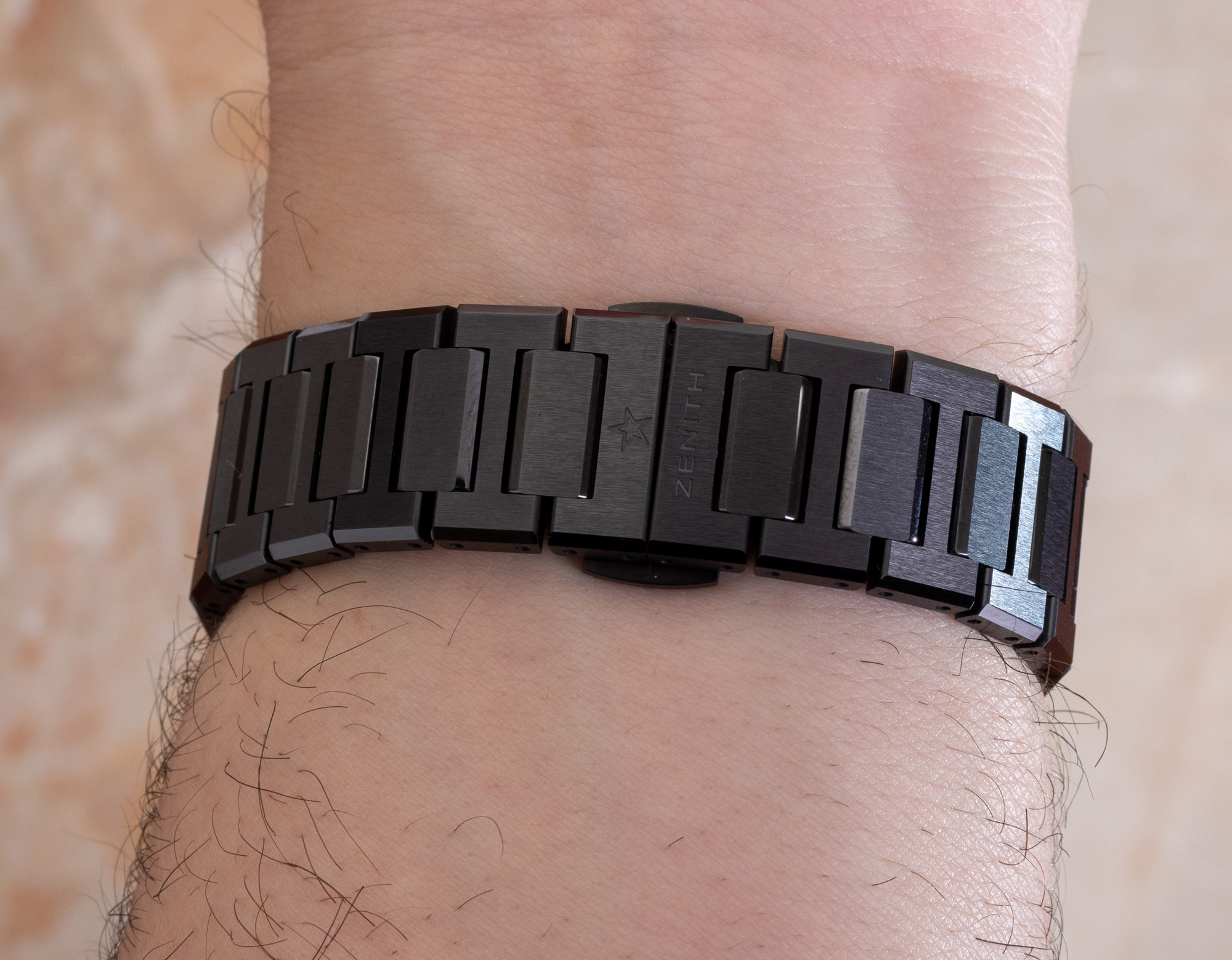
Zenith took this visual preference to heart and developed a movement using El Primero technology that doesn’t have a chronograph — or a seconds hand, for that matter. Zenith designed the caliber 3620 to have a dial that feels like a vestigial foudroyante. In addition to the useful hour and minute hands (along with a date indicator window), the Defy Skyline dial has a subsidiary dial with a hand that makes a full rotation every 10 seconds. This is also the same speed that the central seconds chronograph hand on an El Primero chronograph movement operates. So, what Zenith does is more or less transforms the chronograph seconds hand into a playful and animated subsidiary dial that is mostly for fun. I am going to call this kind of feature a “conversation complication.” Unlike with a minute repeater, you can’t actually explain what the historical purpose of this flying seconds hand is.
The movement has an attractive modern bridge architecture and features 60 hours of power reserve along with silicon parts in the regulation system. The 5Hz operating frequency also means that the movement is going to perform on the more accurate side, at least theoretically. Zenith hasn’t had the easiest time selling El Primero movements that do not feature chronograph complications. Trying new things, such as the approach with the caliber 3620, is interesting and at least protects these timepieces from being boring — a sentiment some consumers apparently find with other simple-dialed 5Hz mechanical timepieces.
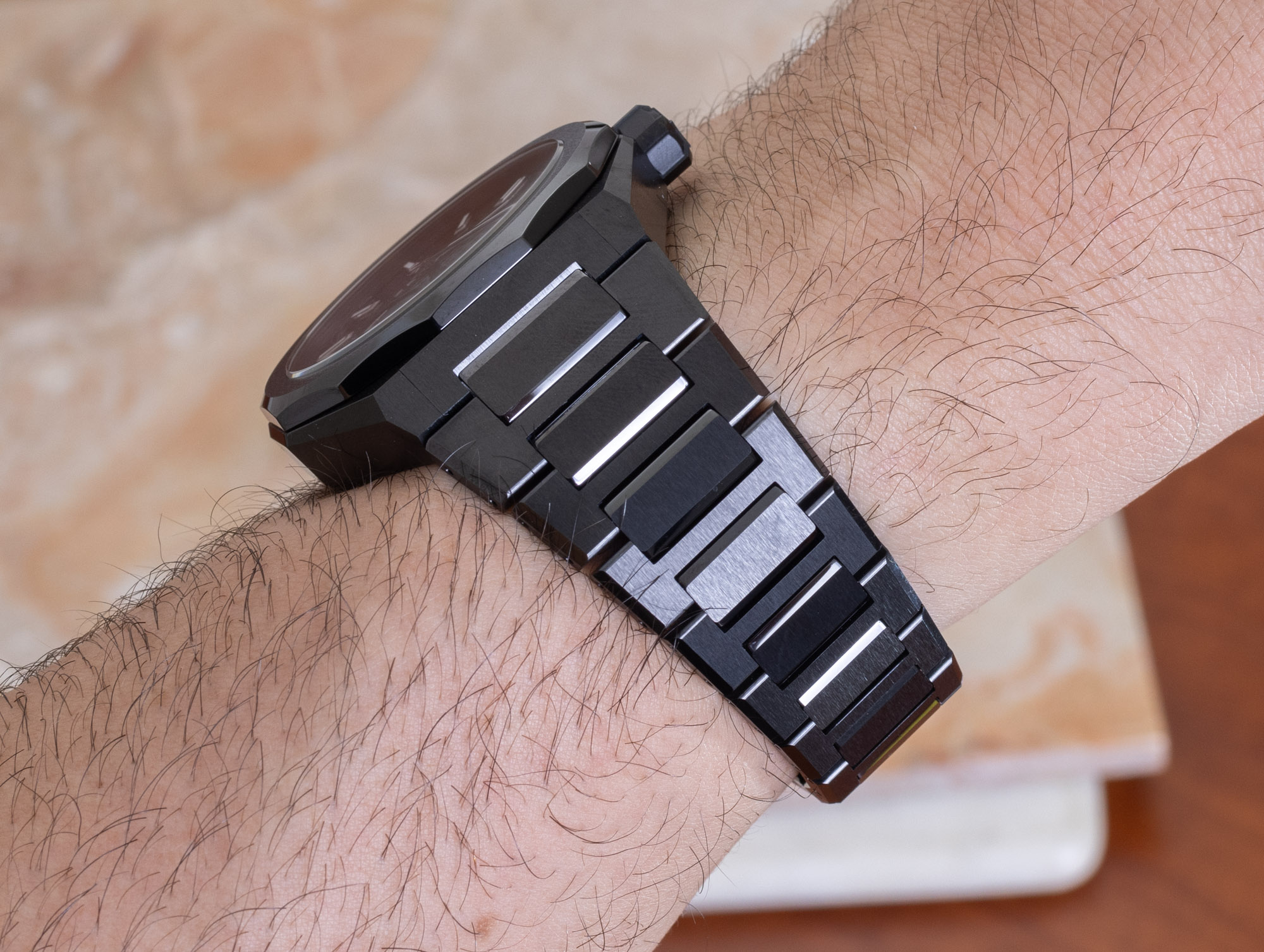
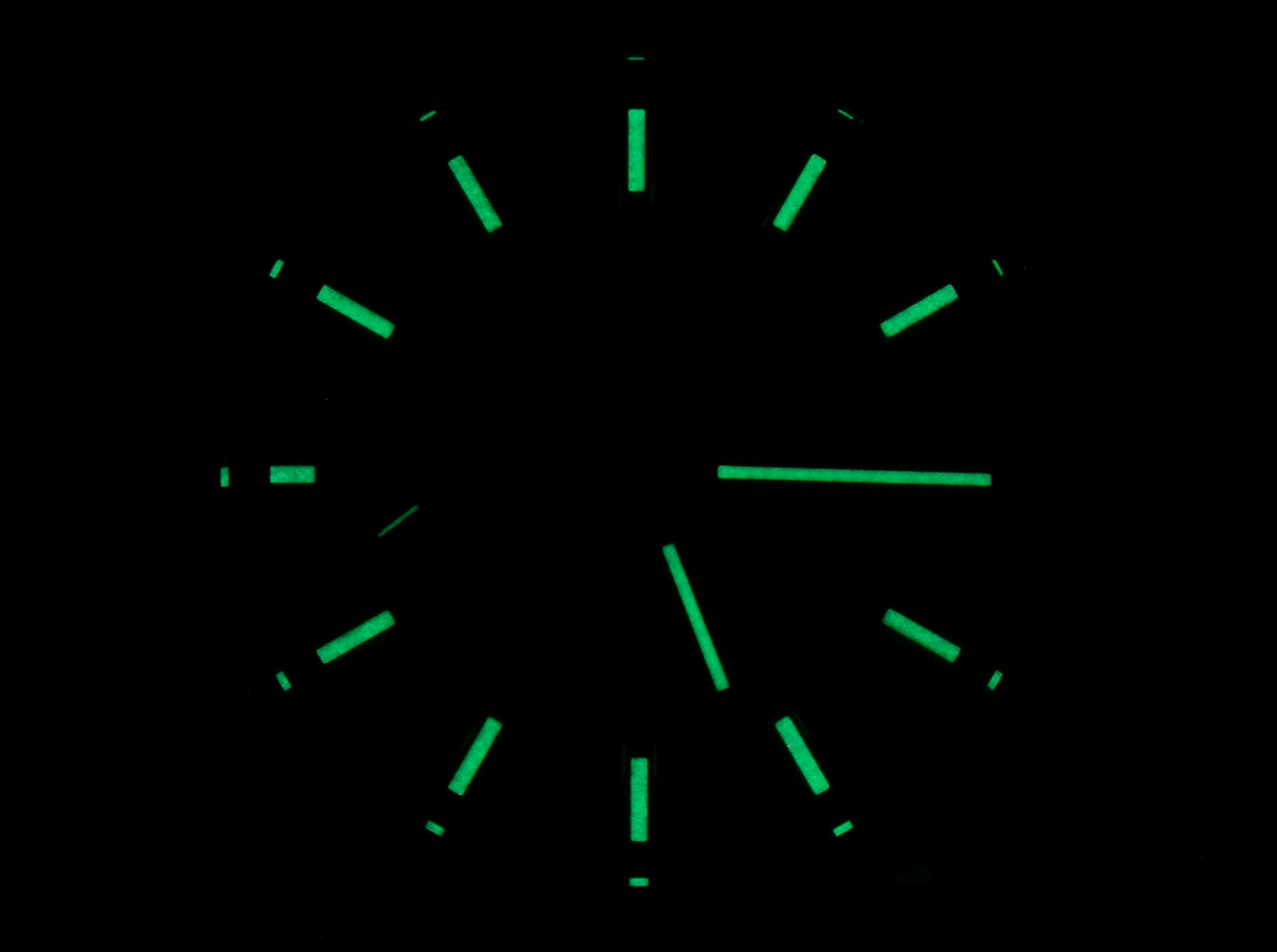
Zenith seemed to have a lot of fun designing the dial of the Defy Skyline. The goal is to fill the space between the necessary hands and markers with something more than boring, flat surfaces. Watches look better with textures and depth on the dials. Zenith also didn’t want another lookalike pattern given the clear homage nature of the Defy Skyline case, octagonal bezel, and bracelet. So, the idea was to create a perforated surface, but with perforations that are small stars. They aren’t the exact same shape as Zenith’s five-pointed star logo, but the familiarity is enough for the dial texture to look both on-brand and original for Zenith.
The Defy Skyline dial is very legible in Zenith fashion, which means large complicated hands and applied hour markers, each with a healthy amount of Super-LumiNova applied. My one issue with the dial is that I feel Zenith didn’t need to have both the star logo and baton hour marker at 12 o’clock. One idea I had was to simply make the 12 o’clock hour marker a Zenith star logo. The way it is now just doesn’t let me visually orient the alignment of the hour markers because in my brain the 12 o’clock hour marker looks too much like the other hour markers. Note that in addition to this “closed dial” version of the Defy Skyline in black ceramic, Zenith also offers a skeletonized dial variant also in black ceramic for $2,000 USD more as the reference 49.9300.3620/78.I001.
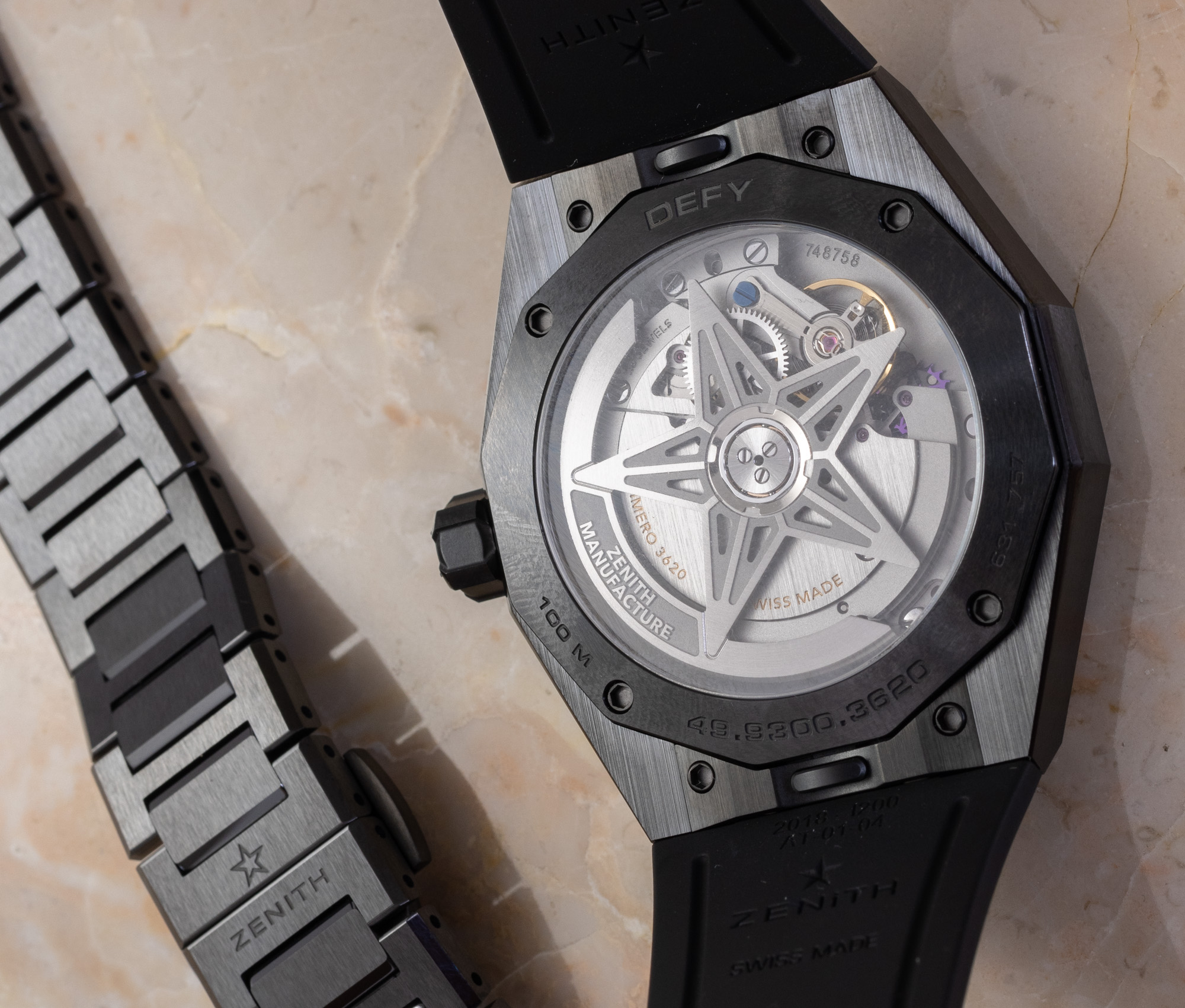
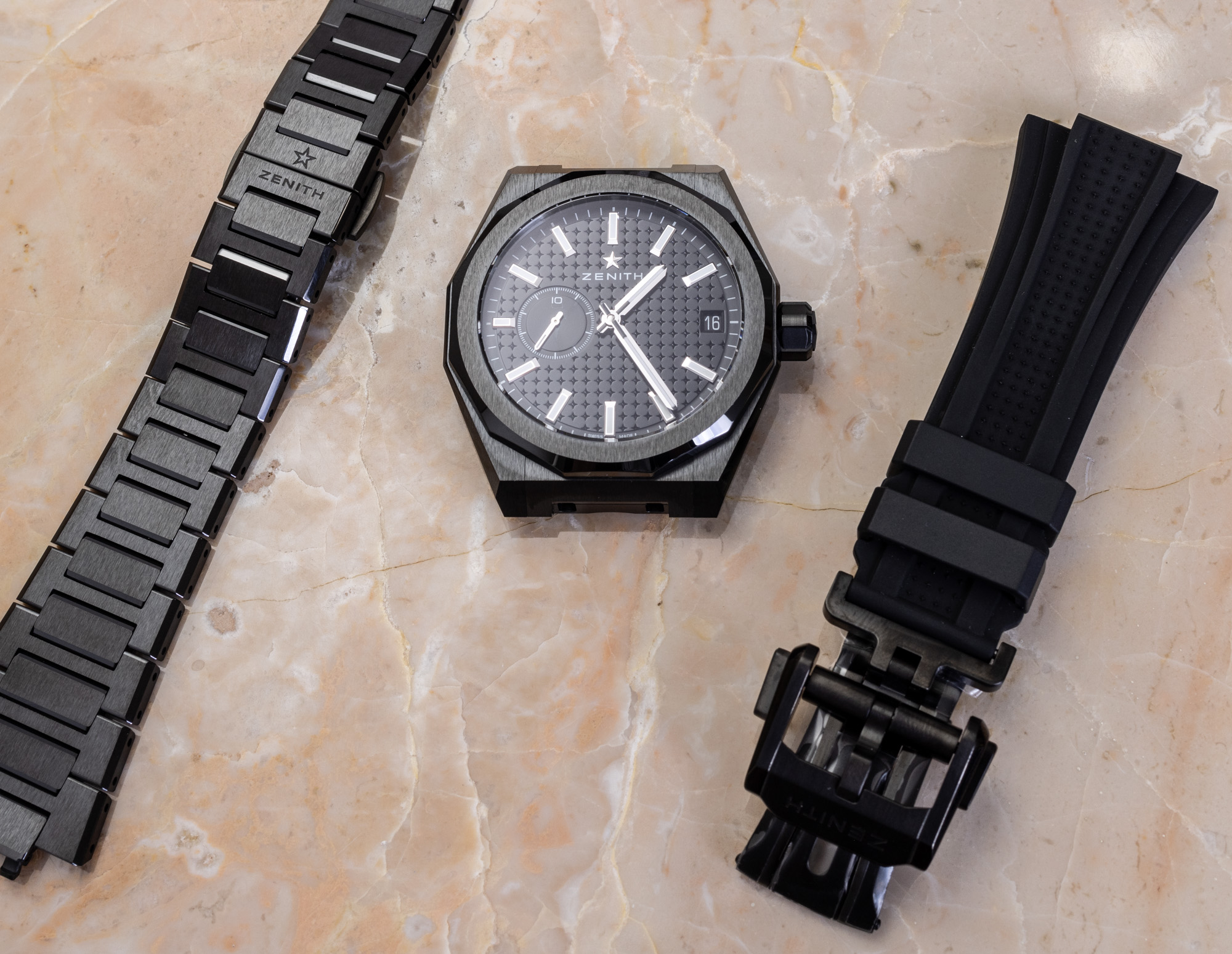
As a fan of the moodiness and sharp precision of black ceramic cases, I found myself really enjoying the Zenith Defy Skyline 49.9300.3620/21.I001 from an aesthetic and visual experience. It offers a bit more personality than steel, with the addition of serious wear resistance, but in what is still a pretty conservative package. How does ceramic otherwise change things? The bracelet is markedly sharper than steel because it is very hard to angle, polish, and edge-soften ceramic as you can do with metal. First, the Defy Skyline case is sharp in design, as is. In metal, you can covertly soften the polished edges to retain a crisp cut that isn’t going to be abrasive to your fingers. With ceramic, however, this is not possible because of the overall hardness of the material. Angular designs in ceramic will be sharp, though, thankfully, the case and bracelet are not too sharp, at least not for me — and I am the type of person who really does complain about sharp bracelets because I find this among the worst wearing sensations around.
The other concern was bracelet fragility. I did baby this black ceramic Defy “Sky Oak” bracelet because the thinness of the links instinctively made me cautious. I really had no particular reason to worry, but I could tell that with links this size, one cannot mentally treat this bracelet as you might a metal one. A few colleagues asked with concern, “So, what happens if a bracelet link breaks?” I think there are two very immediate answers. First, it really isn’t the end of the world. It is going to be much more difficult to break the thicker Defy Skyline case, which would be a serious expense to replace because of all the work of reseating the movement and dial. The same calculation couldn’t possibly apply to replacing bracelet links. My point is that unless Zenith decides to be entirely unreasonable about the cost of buying extra ceramic bracelet links, I don’t think it will be too stress-inducing to have to replace one in the rare instance of it breaking. Second, Zenith includes a backup. Yes, you can think of the rubber strap (on a PVD-coated steel deployant) as being the backup if the ceramic bracelet needs to go into the shop. .
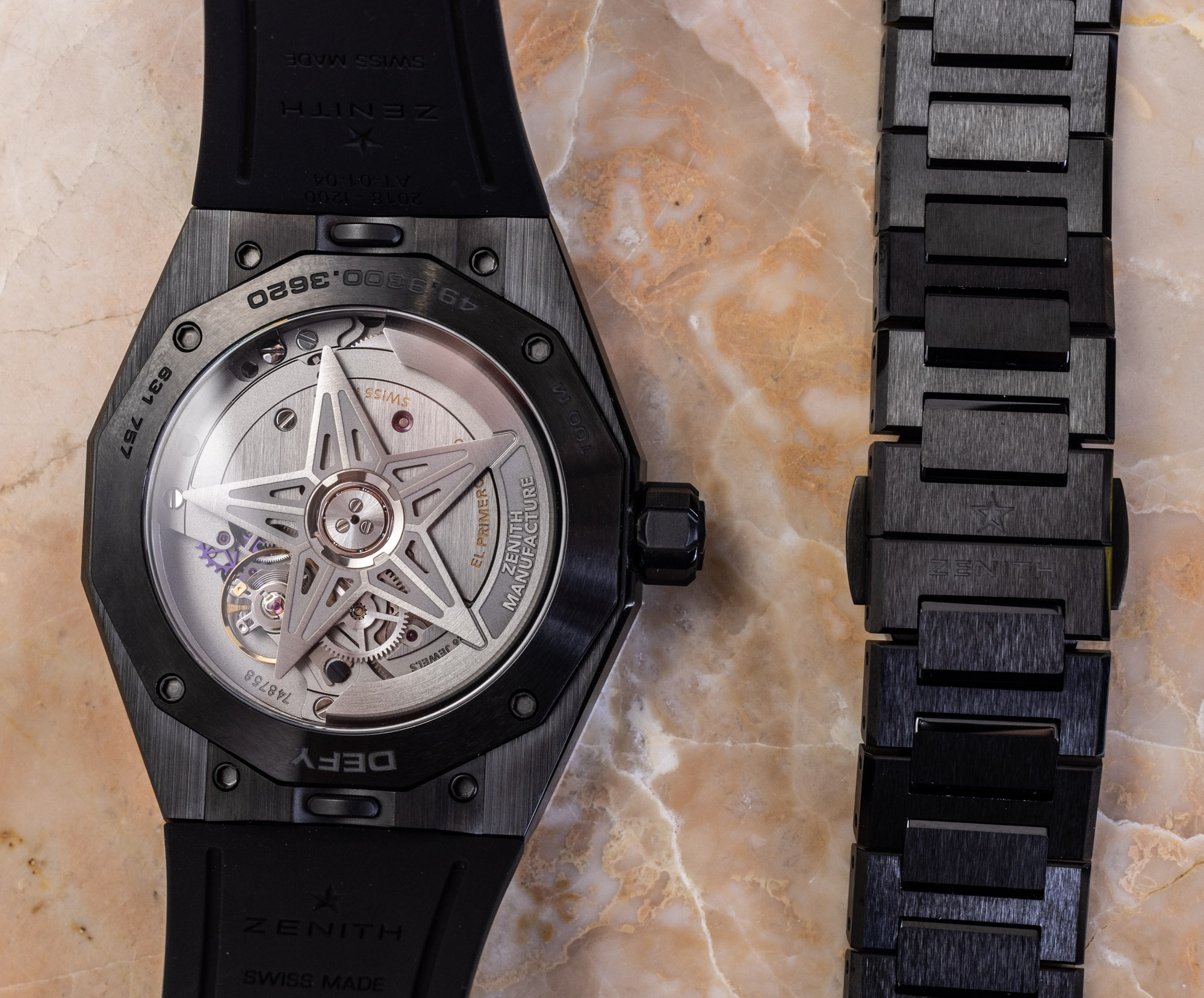
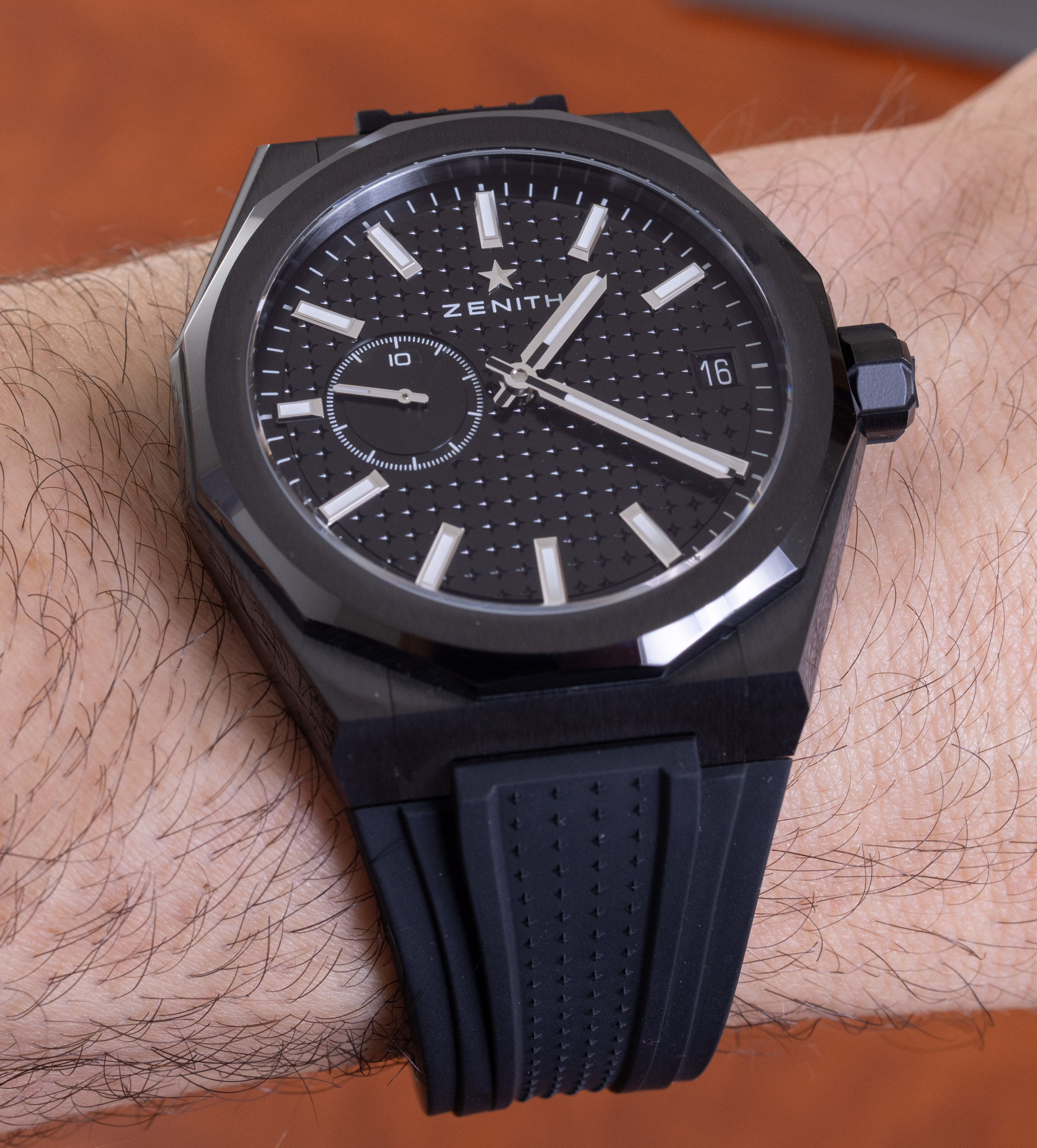
Zenith still has value on its side but the proposition here is less so than the steel versions of the Defy Skyline which cost $6,000 USD less (priced at $9,000 USD) than the ceramic variant. Also, as of writing, there are a very small number of ceramic Defy Skyline watches as compared to the metal variants (which now come in both 41 and 36mm wide sizes). It is true that the lower production numbers and higher machining cost of ceramic do increase the manufacturing costs. That said, it isn’t clear if consumers are willing to pay that much more for ceramic. Ever since the Omega Speedmaster Dark Side Of The Moon, the watch industry has been releasing extremely pretty ceramic sport watches that feel just a bit too expensive when compared with the very same versions in steel. My hope is that the cost to create ceramic watch cases and other parts will go down so that brands are not compelled to charge such a high premium when compared to steel. How many consumers are willing to simply pay for machining time when ceramic as a material is probably around the same price or less than high-quality steel? All I can say for now is that Zenith and brands like it are correct in offering these really attractive ceramic versions of its mainline watches. How long consumers will allow brands to charge so much more for zirconium dioxide is hard to predict. The good news is that prices are likely to keep falling if demand remains strong.
If you can handle the size and find the 10 seconds hand charming, chances are the Zenith Defy Skyline in black ceramic (or otherwise) is going to make you happy. In a lot of ways, this is Zenith doing some of what it does best, and where we see the brand as being the most comfortable, historically. The odd nature of the movement and dial will probably result in Zenith appealing to independent-minded collectors most, but that’s good since by now there are far too many look-alike Royal Oak integrated bracelet watches out there. Zenith actually has a few unique things it can boast about in its offerings. Price for the Zenith Defy Skyline reference 49.9300.3620/21.I001 in black ceramic is $15,000 USD. Learn more at the Zenith watches website here.
Necessary Information:
>Brand: Zenith
>Model: Defy Skyline (reference 49.9300.3620/21.I001 in black ceramic as tested)
>Price: $15,000 USD
>Size: 41mm-wide, ~12mm-thick, ~47mm lug-to-lug distance
>When reviewer would personally wear it: Sharp daily wear watch with the trendiness of a popular-looking integrated bracelet watch and with a mechanical movement intended for niche enthusiasts.
>Friend we’d recommend it to first: Iconoclast who wants the allure of a deservedly popular design and luxury wearing experience with a product that offers plenty more to discuss in conversation.
>Best characteristic of watch: Well-made case and bracelet are also comfortable to wear. Includes added rubber strap. Movement offers performance as well as interesting talking points. Still less expensive than much of the competition in this case and bracelet material.
>Worst characteristic of watch: Expensive when compared to the steel version. Not everyone will appreciate the fast-moving subsidiary hand that doesn’t really have a serious function. Relatively thick case.

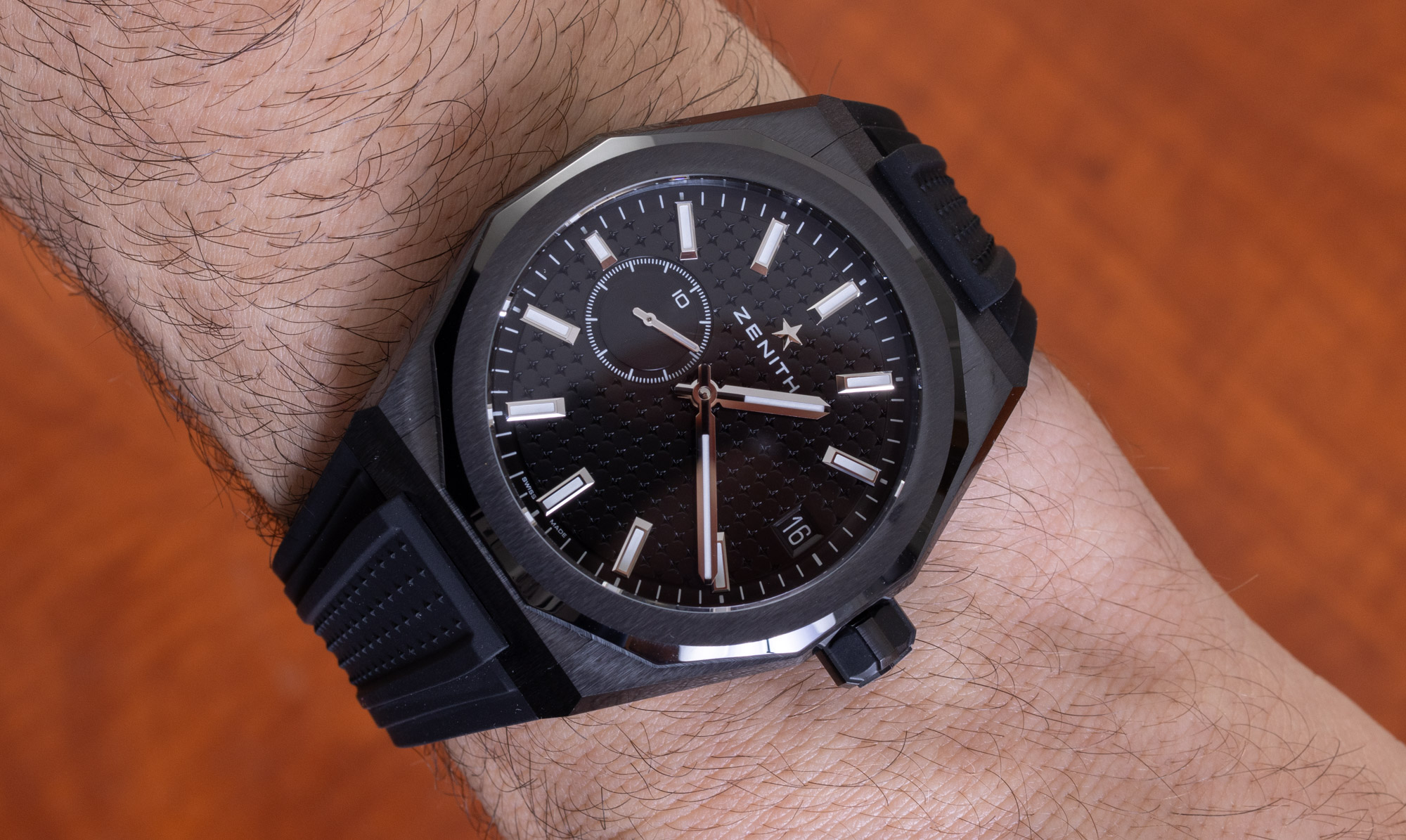
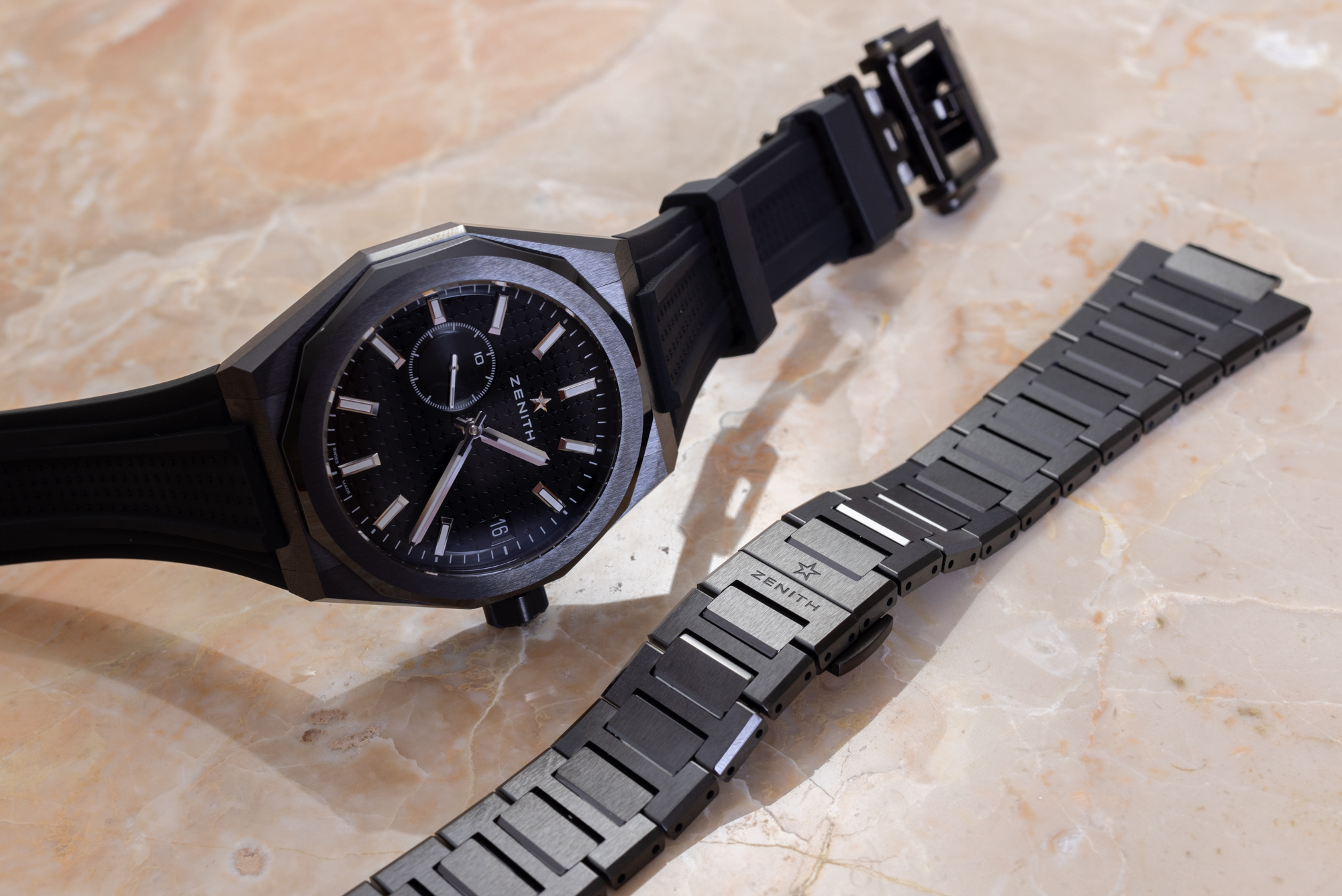 fre
fre